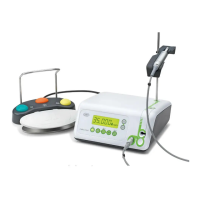
Do you have a question about the W&H implantmed SI-923 and is the answer not in the manual?
| Manufacturer | W&H |
|---|---|
| Model | SI-923 |
| Application | Dental Implantology |
| Operating Frequency | 50/60 Hz |
| Max. Torque at the Instrument | 80 Ncm |
| Coolant Flow | Adjustable |
| Display | LCD |
| Control | Foot Control |
| Power Supply | 220-240V, 50/60Hz |
| Cooling System | Integrated |
| Weight | 2.8 kg |
Explains hazard warning and attention symbols used in the manual, including warnings and cautions.
Covers symbols for general information, manufacturer, CE marking, serial number, and device identification.
Emphasizes patient safety, user qualifications, and intended use of the medical device.
Outlines manufacturer liability and strict adherence to usage instructions for warranty validation.
Lists standard components of the control unit, including universal and irrigant support.
Details optional accessories like irrigation tubing, motor, and foot control.
Covers initial storage, checks for damage, safe operation, and test runs before use.
Prohibits operation in explosive or oxygen-rich environments.
Advises on using correct fuses, avoiding simultaneous contact with patient/contacts, and using approved handpieces.
Explains power failure behavior and that system failure is not critical.
Details safe use of the mains cable, power switch, and disconnection procedures.
Warns about retaining screws and difficulty detecting low speeds.
Warns about potential effects on active implantable medical devices (AIMD) and advises checking patient status.
Stresses following safety notes for foot control, motors, and handpieces.
Details requirements for coolant, irrigation tubing, and proper disposal.
Instructs on cleaning and disinfecting the control unit and supports before initial use.
Identifies and describes the main components on the front panel of the control unit.
Details the connectors, fuse holder, and power switch located on the rear panel.
Explains the function of each button (Green, Grey, Orange, Yellow) on the foot control.
Guides through connecting cables, inserting supports, and attaching the universal support.
Details the procedure for switching the control unit on and off, including LED checks.
Explains how to activate programs (P1-P5) and what is displayed for speed and torque.
Covers controlling the pump and common error messages like motor overheating.
Details how to increase or decrease motor speed using the control unit buttons.
Explains how to set and adjust torque values for programs P4 and P5.
Guides on how to adjust the coolant flow rate for different programs.
Details how to change programs, turn the pump on/off using the foot control.
Explains how to switch to reverse operation and associated signals.
Describes how to change the motor control mode from variable to ON/OFF for program P3.
Details the steps to reset the control unit to its original factory settings.
Explains the thread cutter function (P5), its speed, torque, and operation.
Lists error codes, their meanings, and recommended solutions for the control unit.
Covers adherence to laws, personal protective equipment, and air usage.
Provides guidance on selecting and using appropriate cleaning agents and disinfectants.
Discusses factors affecting product lifetime and recommends service for universal support.
Details immediate cleaning and disinfection of the device after each treatment.
Provides instructions for manual cleaning of universal support, irrigant support, and control unit.
Recommends wipe-down disinfection for all components and lists tested disinfectants.
Describes using washer-disinfectors for universal and irrigant supports, noting control unit is not approved.
Specifies ensuring internal and external dryness after cleaning and disinfection.
Details inspection for damage, soiling, and surface changes after cleaning and sterilization.
Outlines requirements for sterilization packages for the universal support.
Recommends sterilization standards and lists recommended cycles and temperatures.
Presents results of sterilization suitability tests and specifies drying times for different cycles.
Instructs to store sterile goods dust-free and dry, noting shelf life dependency.
States the necessity and frequency of periodic inspections for safety and function.
Advises contacting service partners for malfunctions and proper processing before returning equipment.
Lists various accessories such as cassette, case, supports, and fuses for the device.
Lists additional accessories like motors, foot controls, irrigation tubing, and hose clips.
Provides electrical, dimensional, and performance data for the SI-923 and SI-915 control units.
Details temperature and humidity requirements for storage and operation.
Specifies device classification (Class II), pollution level, overvoltage category, and altitude limits.
Discusses suitable operating environments and general EMC warning notes for the medical device.
States that the device has no critical functions or essential performance features.
Provides guidelines on the use of portable RF equipment and avoiding stacked or adjacent equipment.
Warns that the device is not intended for use near HF surgical equipment.
Presents test results for conducted and radiated electromagnetic emissions according to standards.
Details test results for immunity to ESD, RF fields, bursts, surges, and magnetic fields.
Advises ensuring parts are uncontaminated and following local disposal laws for device, waste, and packaging.
A certificate form to confirm user training on the medical device and understanding of its content.
Explains the 12-month warranty for manufacturing defects and what is not covered.
Directs users to find their nearest authorized W&H service partner via the website or QR code.